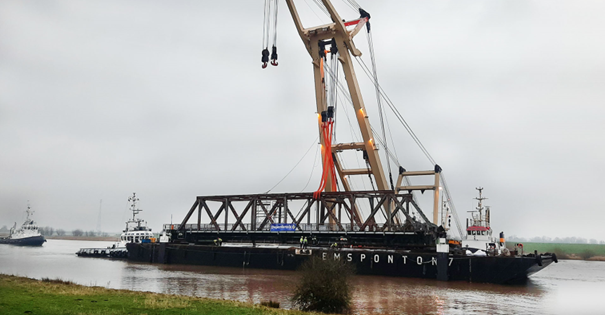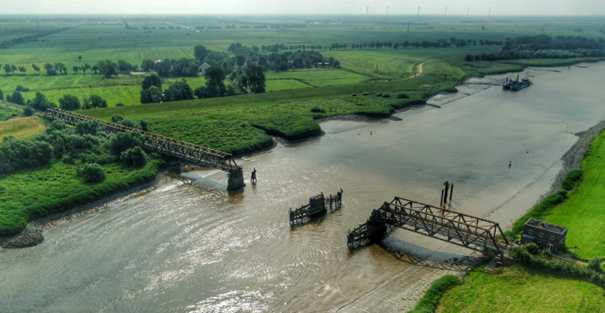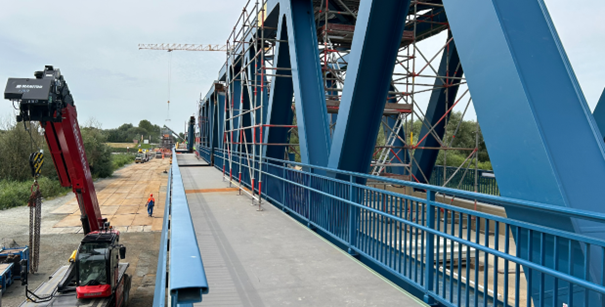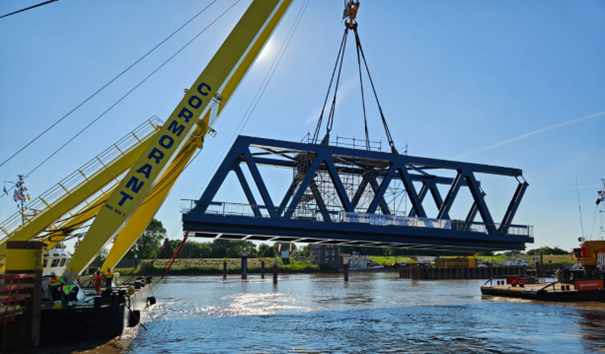
F.l.t.r.: Henning Lohmann, (IBL Ingenieurgesellschaft Behnen) and Alexander Heinemann (DB InfraGO) (August 2024)
Opportunity to build a bridge unique in its kind
Alexander Heinemann, project manager Friesenbrücke at Deutsche Bahn (DB), hails from Hanover and has a background as a structural engineer. Alexander can often be found on the construction site two days a week, keeping a close eye on the progress and catching on to any problems immediately. ‘From my position, it is quite unique to be on the construction site more than in the office in Hanover,’ he says with a laugh. From the office, Alexander is busy with the less visible side of the project, for example coordination to ensure that all stakeholders - from engineers to contractors and client DB - are on the same page.
For Henning Lohmann, Alexander's regular presence works well: ‘It keeps us on our toes and allows us to move quickly.’ Henning is coordinating construction supervisor on site. ‘On site, I am the eyes and ears of the project management in Hanover. From global planning to a specific issue about delivery or the quality of the concrete, I know about it.’ Henning also has a background as a structural engineer and specialises in railway construction. ‘As a child, I was already interested in civil engineering. I wanted to do something practical, something you can see.’ The construction of the Friesenbrücke presented a unique opportunity, a one-off construction project that Henning wanted to supervise from the start.
That this was a feat of engineering is evident from the intended result: at 355 metres, the new Friesenbrücke will be the largest swing bridge for rail traffic in Europe.
Challenges of tidal river Ems
One of the biggest technical challenges in building the Friesenbrücke is the foundation in the river Ems, a tidal river with ebb and flow. ‘We had to install unprecedentedly long bored piles, going as much as 36 metres deep into the ground,’ Henning explains. ‘It also takes into account the washing away of river soil around the piles; recently, a leaching of over 15 metres was observed.’
For Alexander, removing the remains of the old Friesenbrücke was a memorable moment. A first attempt failed; it was quite a challenge to keep the floating crane balanced and hoist the old bridge sections out of the water at just the right point of engagement. One of the highlights for Henning was entering the emptied construction pit in the river: ‘We were about 9 metres below the surface of the Ems, looking at the walls around us we realised the enormous pressure of the water.’

The old bridge section will be loaded onto a pontoon on site in Weener and then transported to Papenburg (December 2021) [Source: DB Netz AG/Alexander Heinemann].
Exploring unexplored territory through innovation
The new Friesenbrücke will be the longest swing bridge for rail traffic in Europe, which means engineering work in partly unexplored territory. Among other things, the Friesenbrücke team used simulations to manage the engineering challenges and identify all possible risks. ‘For example, we examined and simulated the currents and sediments in the Ems, essential for designing the foundation and protecting the bridge from erosion,’ Alexander explains.
Full-scale models were also built to test and optimise the operation of the complex lift-turn element. Both Friesenbrücke experts call it a fun challenge to work interdisciplinary. They coordinate the various disciplines and ensure that everything comes together at the right time, expertise from mechanical engineering, hydraulic engineering, concrete and steel construction and electrical engineering, among others.

Bird's eye view of the Friesenbrücke and the Ems (August 2021) [Source: DB Sicherheit GmbH].
Sizeable logistics puzzle
Proper coordination also plays a key role in logistics: ‘Having all the materials delivered to the construction site at the same time? That will be complete chaos!’ notes Henning. ‘We have to prioritise and fine-tune which materials are needed when.’
Due to the war in Ukraine, the delivery of materials did not always go according to plan. This forced Alexander and Henning to work with contractors to find solutions, for example for the delayed delivery of steel. ‘Europe's largest steel plant is in Ukraine,’ Henning explains. From the contractors came the idea to build the bridge parts first in Papenburg and transport them by floating crane via the Ems. This allowed the different bridge parts to be built in parallel from each other while steel delivery was underway.
So much more than engineering and construction
Communication within the project team is intense. ‘We are in a small technical universe, so to speak,’ says Henning. ‘It's not a 9-to-5 job; you really have to have passion for the project.’ External communication, for example with local authorities, also plays an important role. For example, there was a desire from the municipality and surrounding area to install a bicycle and pedestrian bridge, an additional element influencing the technical design of the bridge's turning section.
 Friesenbrücke also provides a connection for pedestrians and cyclists (August 2024)
Friesenbrücke also provides a connection for pedestrians and cyclists (August 2024)
In addition, sustainability is an important issue. ‘The bridge is designed for a lifespan of 100 years,’ Alexander explains. ‘We pay attention to the proper disposal of old materials and apply environmentally friendly construction practices.’ The steel from the old Friesenbrücke is recycled and reused by steel processors. ‘Perhaps the former bridge was processed into beverage cans,’ Henning suggests.
Bridge builders and the power of collaboration
Both speak enthusiastically about the cooperation within the team. ‘The gap between client and contractors is small. Everyone is willing to go the extra mile; challenges are really tackled together and solution-oriented.’ Alexander adds: ‘I have learned that you cannot do everything yourself. The trust and openness between all parties has proved essential.’
The construction site next to the Friesenbrücke and in Papenburg usually employs around 100 people and in busy periods towards 200. International cooperation is everyday practice, e.g. the culverts for pouring concrete came from the Netherlands, the large floating crane from Belgium and the company MCE from Austria is responsible for the steel construction and engineering of the new bridge. Thus, this construction project has not only the usual players, but all kinds of new ones.
How does it continue?
Construction of the new Friesenbrücke is progressing well; four bridge sections have already been installed. ‘A 70-metre-long bridge section will follow in autumn. Finally, the turning section, jokingly called the Big Mac at the construction site, will follow in December,’ Alexander reports.
 Installation of the first bridge sections for the new Friesenbrücke (August 2024)
Installation of the first bridge sections for the new Friesenbrücke (August 2024)
Completion is scheduled for summer 2025, when train traffic between Groningen and Bremen will resume. Whether we should then fear another collision with the brand new bridge? Henning shakes his head: ‘The new Friesenbrücke has a doubled passage width and the current ensures that ships are automatically guided through the bridge opening, so to speak.’ Previously, ships had to steer against the current, which was more challenging and risky.
Alexander and Henning look forward to the completion of the bridge, but also realise that a project of this size and uniqueness will not come again anytime soon.
Admiring the new Friesenbrücke in advance? Watch an impressive video from DB here.